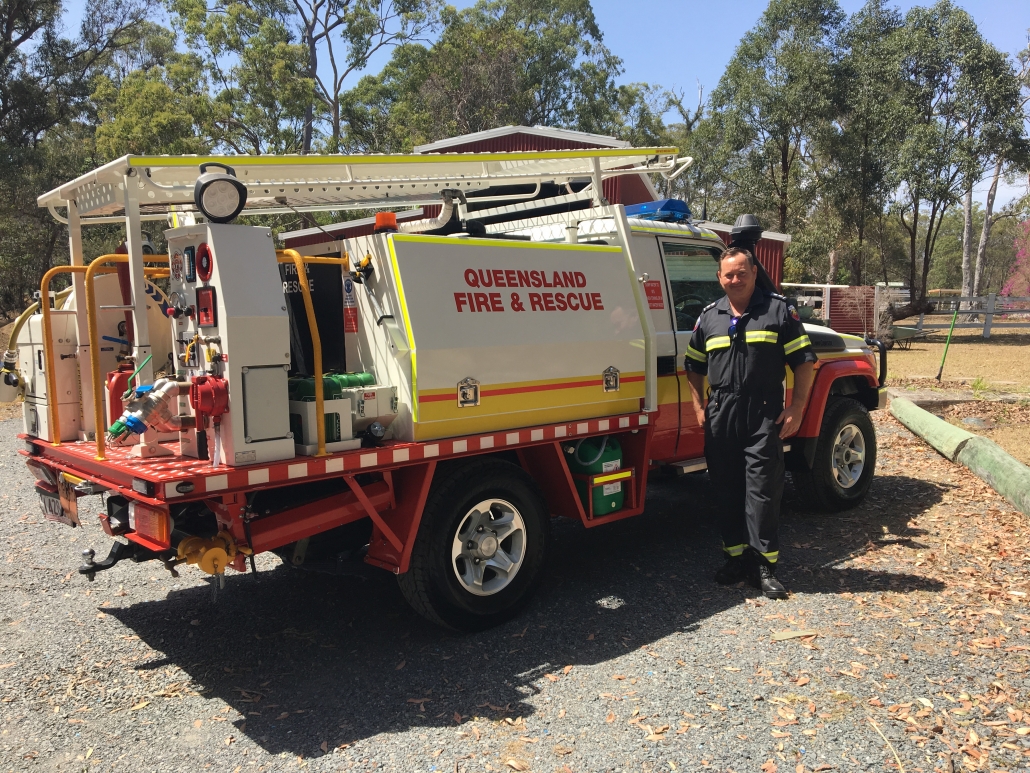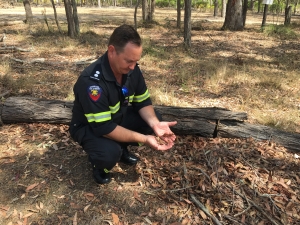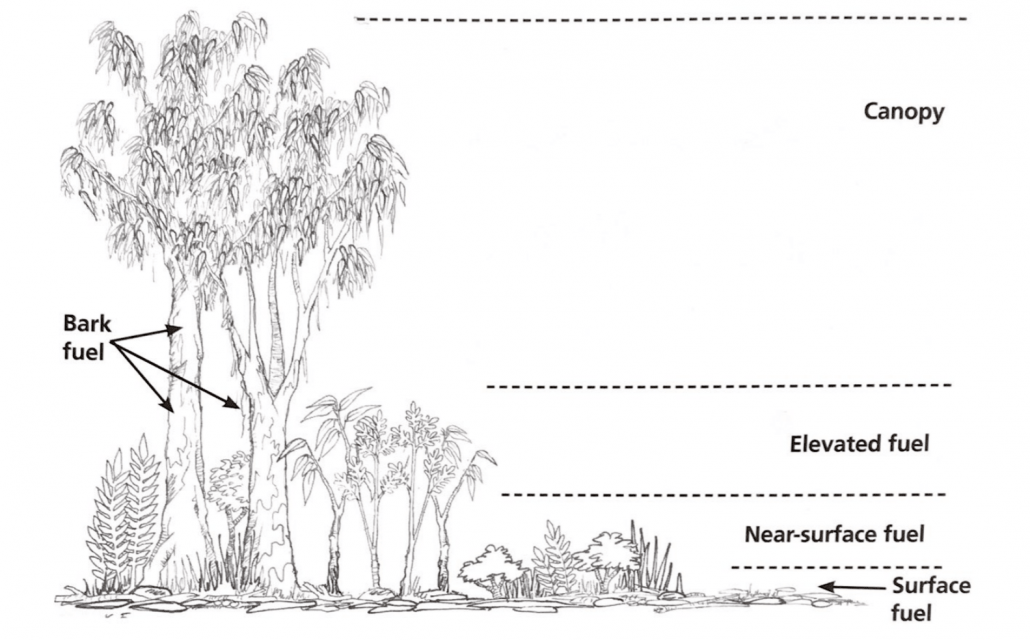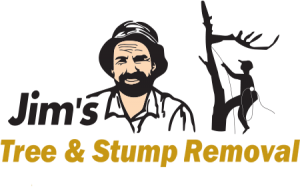Are my trees a fire hazard?
My brief was to write about fire mitigation. So what better place to begin, I decided, than to organise a fire fuel inspection on my own property. Looking out from our cabin, perched on the edge of a crisp dry 10 acre block of natural bushland, my next thought was – why haven’t I done this before?
Our priority over the last 20 years has always been to rid our patch of exotic weeds and allow as many native species as possible to return – indeed with Council’s encouragement. But as I await the pending inspection, with dry leaf crumbling beneath my feet, a rather uneasy feeling comes over me. Could our enthusiasm to bring back the bush be met with disapproval from the Region iZone Officer?

Fire Warden Graham Wells is the officer responsible for the rural-urban interface zone (iZone) where I live in Redland City and also for Brisbane and Moreton Bay. His job involves liaising with outside agencies and providing a one-on-one service to land owners who want specific information about how to prepare and maintain their properties against bushfires. Although he never knows from one day to the next where work might take him, he describes it as the “best job in the world”.
Before reaching our bush hideaway, Graham has already googled the property, searching for its size, proximity to bushland, any nearby fire breaks, water sources and escape routes. It is normal procedure to do a risk assessment before coming on site to “ground truth” what has been seen from satellite imagery.
On his arrival, Graham asks about our concerns to ascertain whether there is a “real risk” as opposed to a “perceived risk”.
“Images of raging fires in trees may give the perception that fire will instantly spread to tall tree canopies and destroy homes but the real fire hazard lies in the condition of the understory,” he explains.


The fire fuel assessment is a standard process and doesn’t take long. Each fuel layer [see diagram] is assessed in multiple plots and given a hazard rating with emphasis on how the fuel is arranged within each layer. The hazard ratings are then combined to produce an Overall Fuel Hazard rating that ranges from Low to Extreme.
Within minutes Graham is able to gain an understanding of how the fuel arrangement will influence fire behaviour and the chances of controlling a bushfire. Despite our property’s wild and natural presence, we were surprised to learn its Overall Fuel Hazard rating is moderate. This is partly due to our strict regime of removing invasive weeds and also the well-maintained firebreaks meandering through the bushland centre and along neighbouring properties. It was reassuring to know that, apart from a few basic jobs – such as trimming back a couple of overhanging dead branches and raking up accumulating leaves under the cabin – we could be satisfied we had done our part. Not that this may provide any relief in the event of catastrophic or extreme fire conditions, of course.
On radio that night echoed strong warnings from Queensland Fire and Emergency Services Director of Rural Operations, James Haig.
“Bushfire prevention is very much a partnership with emergency services, councils and community,” he stressed.
“It’s the combined effort that’s important. We are never going to have enough resources to fight every fire. It’s important the community understands what to do if a fire does occur and to have a personalised plan ready so that they’re not trying to make decisions under extreme circumstances. In thinking it through beforehand, you can get a better understanding of what needs to be done.
“It’s always the one thing you’re not aware of that is likely to bring you unstuck,” he warned.
Complete your preparation for the approaching fire
Whether you are staying or leaving, there are some basic precautions you can take to help protect your property from a fire well before the fire front arrives.
- Move cars to a safe location
- Remove garden furniture, door mats and other items
- Close windows and doors and shut blinds
- Take down curtains and move furniture away from windows
- Seal gaps under doors and windows with wet towels
- Bring pets inside and restrain them (leash, cage, or secure room) and provide water
- Block downpipes (at the top) and fill gutters with water if possible
- Wet down the sides of buildings, decks and close shrubbery in the likely path of the bushfire
- Wet down fine fuels close to buildings
- Turn on garden sprinklers for 30 minutes before the bushfire arrives
- Fill containers with water – baths, sinks, buckets, wheelie bins
- Tune in to warnings to monitor local radio, websites or social media for updates
- Put on protective clothing
- Drink lots of water.
How fire fuel on your property is assessed.
Information from the Victorian Government Department of Sustainability and Environment.

Fuel in forested areas is divided into four layers from ground surface elevating to upper bark; canopy fuels are not assessed.
Surface fine fuels includes dead plant material, such as leaves, grass, bark and twigs thinner than 6mm, and live plant material thinner than 3mm.
It usually contributes to the most to fuel load quantity and rate of spread of a fire. Fuel hazard is highest when depth is greater than 30mm.
Near-surface fuels consist of live and dead vegetation not lying on the ground but effectively connected. Fuel hazard is highest when fuels are densely arranged and with horizontal or vertical continuity that promotes the spread of flames.
Some plants may transition back and forth between different layers. For example, juvenile bracken fern can be classified as near-surface fuel before becoming elevated fuel as it matures. Once it dies and collapses it may become near-surface fuel again.
Elevated fine fuels are mainly upright in orientation. Hazard increases when the foliage, twigs and other fuel particles are very fine, dry, densely arranged or the proportion of dead material is high.
Bark fuel is the bark on tree trunks and branches and is separated into three broad bark types: fine fibrous barks such as stringy barks; ribbon or candle barks; and other bark types including smooth, platy, papery and coarsely fibrous.
Bark hazard increases over time as thickness and looseness of old bark and ribbons increases.
Repeated low intensity fires may produce a ‘black sock’ effect on the base of the trunk but this may have limited effect in reducing the overall quantity.
[jims_author_box av_uid=’av-2rn2l8′]



